Anne Bonny is on the chase. She had been following the distant scent of a whale pod when a strange new scent and a distinct sound of splashing caused her to veer hard to starboard in the direction of the islands along the coastline. As she approaches closer, her many senses quickly inform her that a large beast is swimming slowly and clumsily at the surface. A landlubber out of its element. An easy prize.
It was the presence of lush vegetation on the islands that had enticed the big male ambelodont to enter the cool blue waters that hot morning. Now his eyes catch sight of a tall dark fin slicing through the water directly towards him. Alarmed, he begins paddling faster, but to no avail. Anne Bonny’s great head breaches the surface and her jaws split wide open to reveal jagged rows of slicing teeth! The terrified ambelodont only has time to let out a final bellow before his body is cleaved to the brisket in a crimson froth. Showing no quarter, Anne Bonny swings her head from side to side, reddening the waters even further. Then, with a mighty swish of her tail, she dives beneath the surface and disappears with her prize, leaving only a large spill of blood and guts for the sea scavengers to squabble over . . .
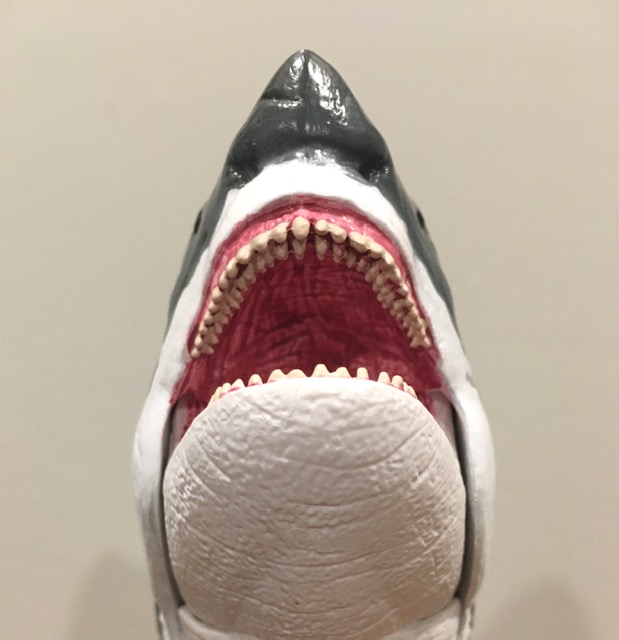
Ah, Megalodon, the only prehistoric animal best known by its species name rather than its genus. On that note, its taxonomical history is a long and somewhat complicated one. It was first named Carcharodon megalodon in 1843 and classified as part of the family Lamnidae, which consists of mackerel and great white sharks. More than a century later, scientists determined that its dental similarity with Lamnidae was just the result of convergent evolution, and so the great shark was reclassified into the family Otodontidae (megatoothed sharks) under the genus Carcharocles. And as of this writing, there’s debate over whether it belongs in the genus Otodus, so perhaps it’s a good thing that most people know this animal simply as Megalodon, because at least that isn’t going to change. And now that we’ve got the vignette and the history under our belt, let’s get down to the main course: the 2020 Deluxe Megalodon figure from CollectA!

What a leviathan this is! With a length of 28.5 cm, a flipperspan of 13 cm, and a 9 cm tall caudal fin at the end of the tail, this Megalodon is in the same size class as previous CollectA sea scourges like the Dunkleosteus and the Kronosaurus. Determining Megalodon’s true size has always been tricky, what with the only available remains being scores of fossilized teeth and some vertebral centra, but the most reasonable estimates place it between 15 and 18 metres long, with females being larger than males. Megalodon was probably both the biggest shark and the biggest fish of all time.
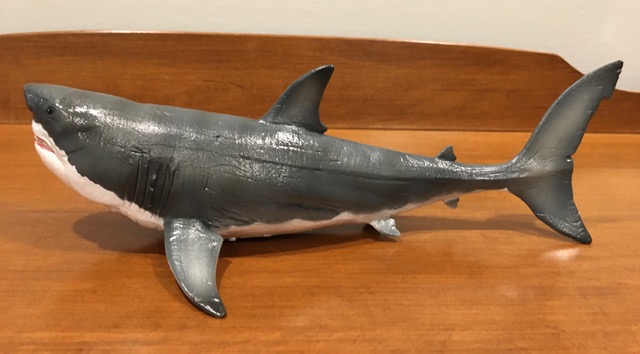
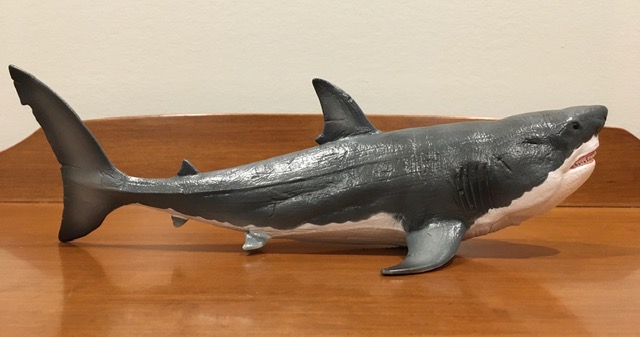
This figure is also quite solid and fairly heavy, and not definitely meant for very young children to play with. Like all shark figures (at least as far as I know), this one is immediately recognizable as a female due to the absence of claspers between its pelvic fins. In keeping with my longtime habit of bestowing pirate-themed names upon my prehistoric water denizens, I’ve dubbed this one Anne Bonny, after the famous female pirate of the Caribbean.
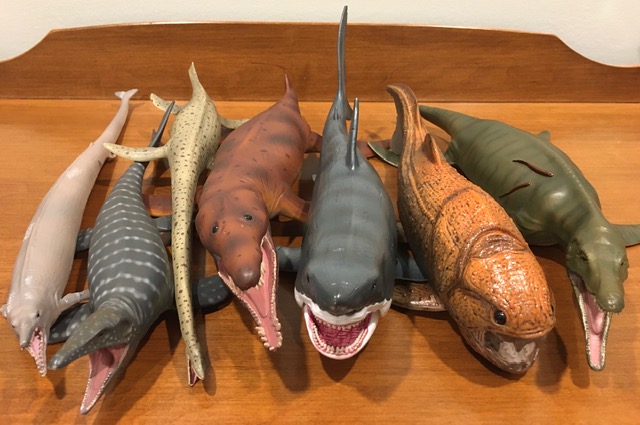
As you can see, Anne Bonny follows in the longtime tradition of portraying Megalodon as being very similar in appearance to a colossal great white shark. More recently, some researchers have proposed that it may have more closely resembled a whale shark, or a sand tiger shark, or an oceanic whitetip shark. But the simple truth of the matter is that we don’t know, we probably never will know, and any and all Megalodon depictions still end up being largely speculative. And for myself at least, there’s just something inherently appealing about Anne Bonny’s ‘classic’ appearance. I reckon it’s a bit like how many people still adore the look of the Jurassic Park franchise’s Tyrannosaurus rex.
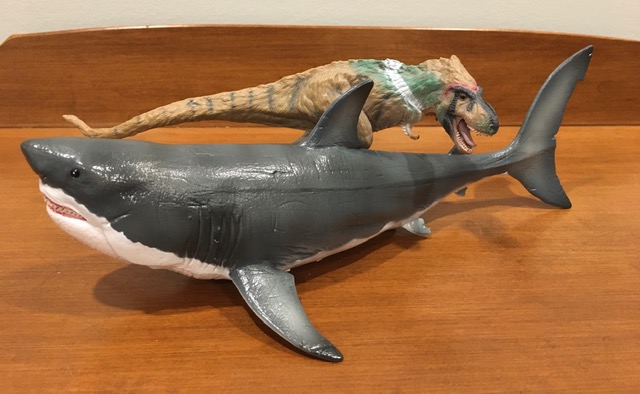
Just like any Megalodon representation, Anne Bonny bears a number of distinguishing characteristics. Her body is more robust than the average great white’s, with a deeper head, a wider, blunter snout, proportionally smaller teeth, and a fatter caudal fin at the end of her tail. Her main colours are dark grey and white with faint dark vertical stripes running down her body, darkened tips on her pectoral, dorsal, and caudal fins, glossy black eyes, and a dark pink mouth lined with off-white teeth, which I’ll describe in detail later on. Her left eye features a tiny white dot, but her right one is entirely black. A factory error, perhaps?
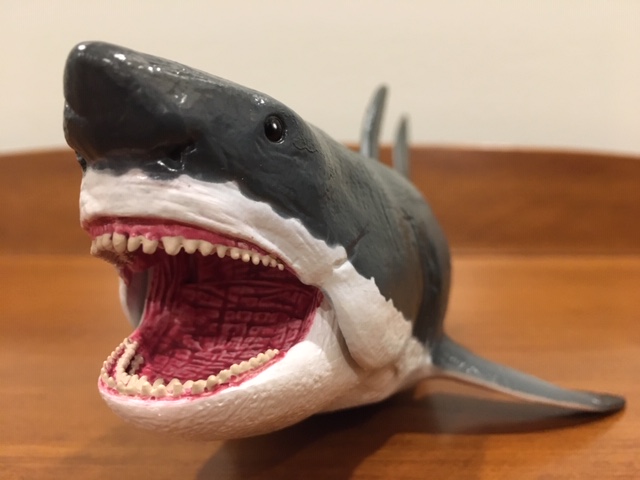
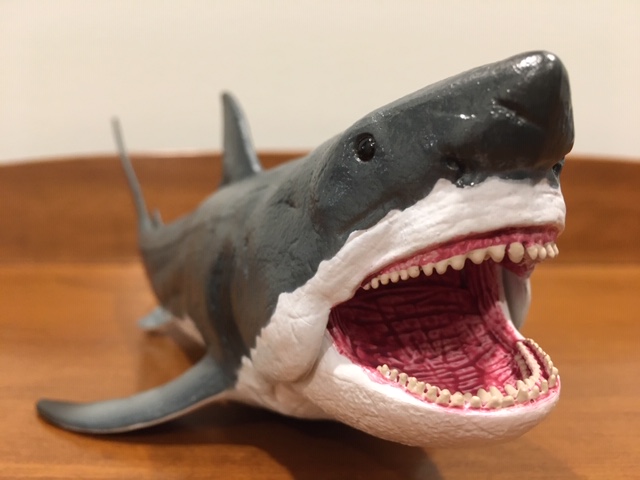
Some might argue that it would have been nicer if CollectA had chosen a more original main colour for this figure, such as blue or brown or even a lighter shade of grey with some sharper stripes or spits, and that’s fair, but there can be no denying that this scheme would be ideal for an enormous predatory shark. Dark on top and light on bottom is a tried and true combination.
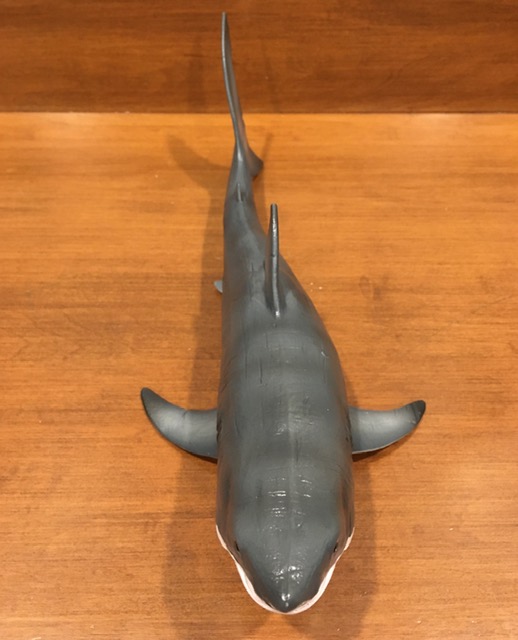
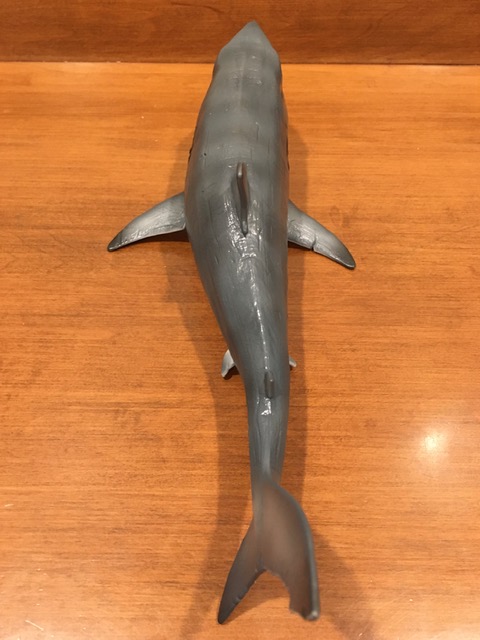
Many shark figures tend to have smooth skin, but not Anne Bonny. Instead, her hide has a faint pitted texture with visible lateral lines and a good amount of wrinkles, especially on her underbelly. Her tail features caudal keels, although I reckon they should have been sculpted a little bigger. The inside of her cavernous mouth is covered in crisscrossing grooves, her nostrils are large and prominent, and five gill slits are correctly placed on her sides. And to top it all off, Anne Bonny bears a great many battle scars on her body, including on her snout, around her mouth, across her gills, along her sides, and on her fins. All this, along with her massive girth, makes Anne Bonny look like a tough and grizzled survivor of a harsh and merciless environment. Despite being an apex predator, Megalodon faced competition in the form of macroraptorial sperm whales like Brygmophyseter and Livyatan, the latter of which rivalled it in size. It also probably engaged in cannibalism.

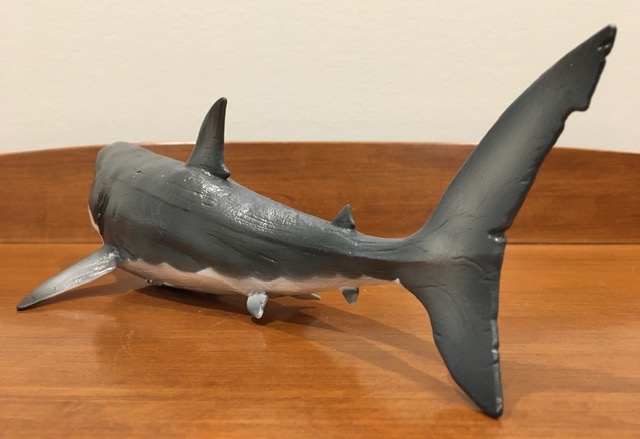

Which brings us to that most famous part of any shark’s anatomy: the jaws. Like the aforementioned Dunkleosteus and Kronosaurus, Anne Bonny boasts a hinged lower jaw, allowing her jaws to open to about a 45 degree angle. As you can clearly see from the image below, this definitely allows for some fun and imaginative play, but the downside, of course, is that there are noticeable seams. The pointy teeth are small, but very impressively sculpted, with three visible rows on both the upper and lower jaws. They look quite intimidating and deadly, but I think they would have looked even better had they been sculpted a little bit larger, and if the rows extended further back along the jaws.
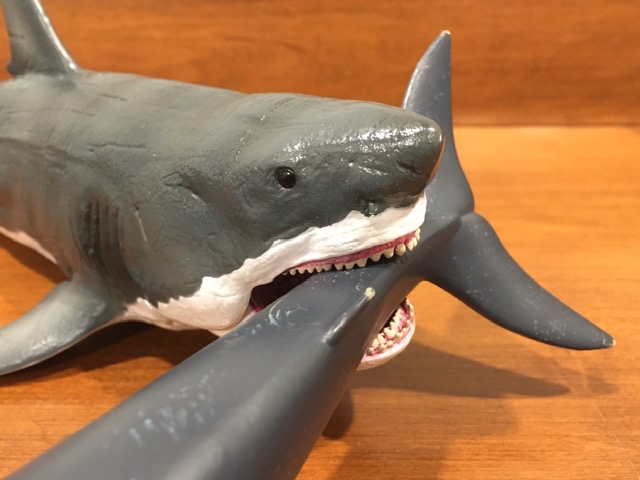
Whereas the teeth on today’s great white shark are evolved primarily for slicing through flesh, Megalodon boasted an estimated bite force of 180,000 newtons, or 40,000 lbs per square inch, which is a stronger chomp than that of any other animal that has ever lived, including T. rex. Adults would have eaten whatever they wanted, including a variety of whales, other marine mammals, and fish. And just like modern sharks, they would have happily devoured land animals when the opportunity presented itself!
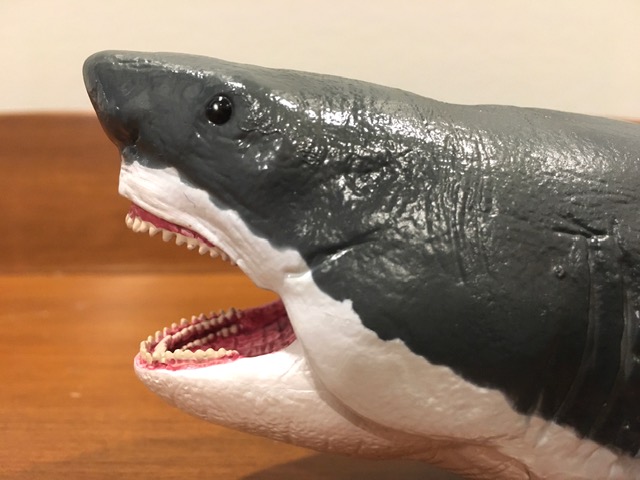
I’ve been fascinated with Megalodon ever since the first time I laid eyes on it in this children’s book featuring artwork by Peter Zallinger, and this figure certainly meets all the criteria for a bloodthirsty giant prehistoric shark. I will also note that my 2.5 year old son was very impressed by Anne Bonny after I accidentally left her out on the couch in the living room—which probably means I’ll have to get him his own figure once I deem him old enough to play with it safely. As it was, I ended up giving him two new sea turtle figures to alleviate his sadness after I took Anne Bonny away from him.
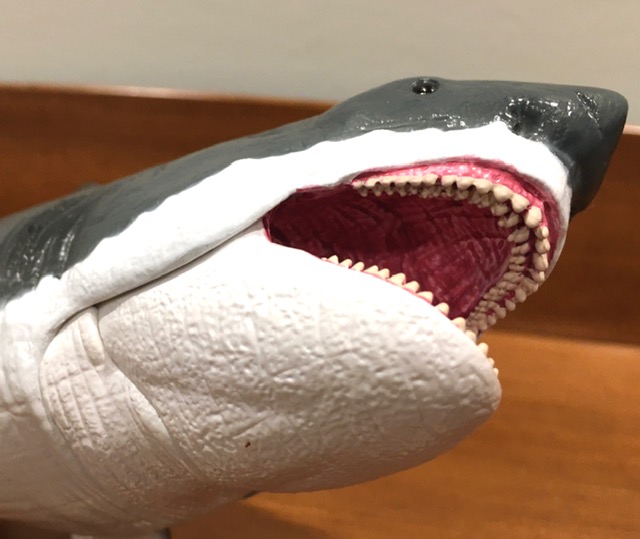
As I noted before, since any and all Megalodon restorations are largely speculative, it’s difficult to judge the accuracy of Anne Bonny here. Could she have been made with a different body, a different-shaped snout, and a different colour scheme? Absolutely, and it likely would have made for a very cool toy. Is she still a very cool toy as she is? Yes, I do believe so. If you’re a fan of prehistoric sea monsters, then you’ll probably be happy to add Anne Bonny to your scurvy crew!
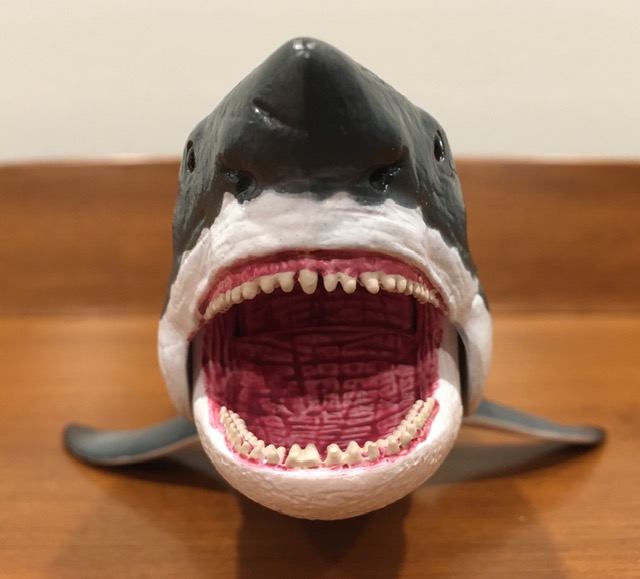
A hearty thanks to the fine folks at CollectA for this booty! Hopefully we’ll see Livyatan or Helicoprion in the future!
Disclaimer: links to Ebay and Amazon on the DinoToyBlog are affiliate links, so we make a small commission if you use them. Thanks for supporting us!




Marha jó,talán a legjobb Megalodon a piacon,de nekem a Papos is tetszik,csakhogy ez kisebb ami zavar.CollectA Jaws!!!!
I just found this on eBay for 30$
Nice review. I contemplated getting this when it comes out, but now that I see its size, I will probably stick with my Safari version. I’d consider the PNSO one, if it ever became easier to acquire.
I really can’t stand the Safari version anymore. Those terrible teeth.
I actually just got this today to replace the Safari figure! Man, glad I did!
Fantastic review, and I really dig the size comparison with CollectA’s other large marine animals too.
Your reviews are always so fun. Particular kudos for the phrase “cleaved to the brisket in a crimson froth.”
Thanks! “Cleaved to the brisket” is pirate talk for slicing someone open from the shoulder to the abdomen, so I figured it would appropriately describe Anne Bonny‘s attack.
I had that Peter Zallinger book, as well as a larger book of his dinosaur artwork, and it was incredibly influential on me as a kid. Some of the best, most detailed paleo-artwork of the time, especially for a kid-friendly book.
Thanks for reminding me of it!
Yeah, I wish it was still in print, or that I still had my old copy. Zallinger will always be one of the greatest.
The figure is good, but honestly my question is the following: Is it much more scientifically accurate than the PNSO megalodon? Another question is perhaps the best solid PVC figures made to date? Honestly, to me, it seems superior to other brands of prehistoric toy animals.
The size is without a doubt immense for a PVC megalodon it is perhaps the largest solid PVC megalodon made to date.
I congratulate Suspsy for her magnificent and extensive article, it gives an exact idea of what kind of figure we are talking about for me of first quality and sincerely it is not a toy for small children, that is another aspect that we must celebrate for the Collecta megalodon. What perhaps it would put as a defect is its articulated jaw that detracts in some way from beauty to the figure, a megalodon without articulated jaws would have been more preferable, especially because that way the seams of the jaw would not be seen, it is my appreciation.
The five stars for the Collecta megalodon.
Thank you. I would say that the CollectA and the PNSO are on par in terms of scientific accuracy, for the simple reason that no one can really say for sure what Megalodon looked like.
Great review of a good figure. Also, brilliant nod to Jaws with the first photo.
Thanks!